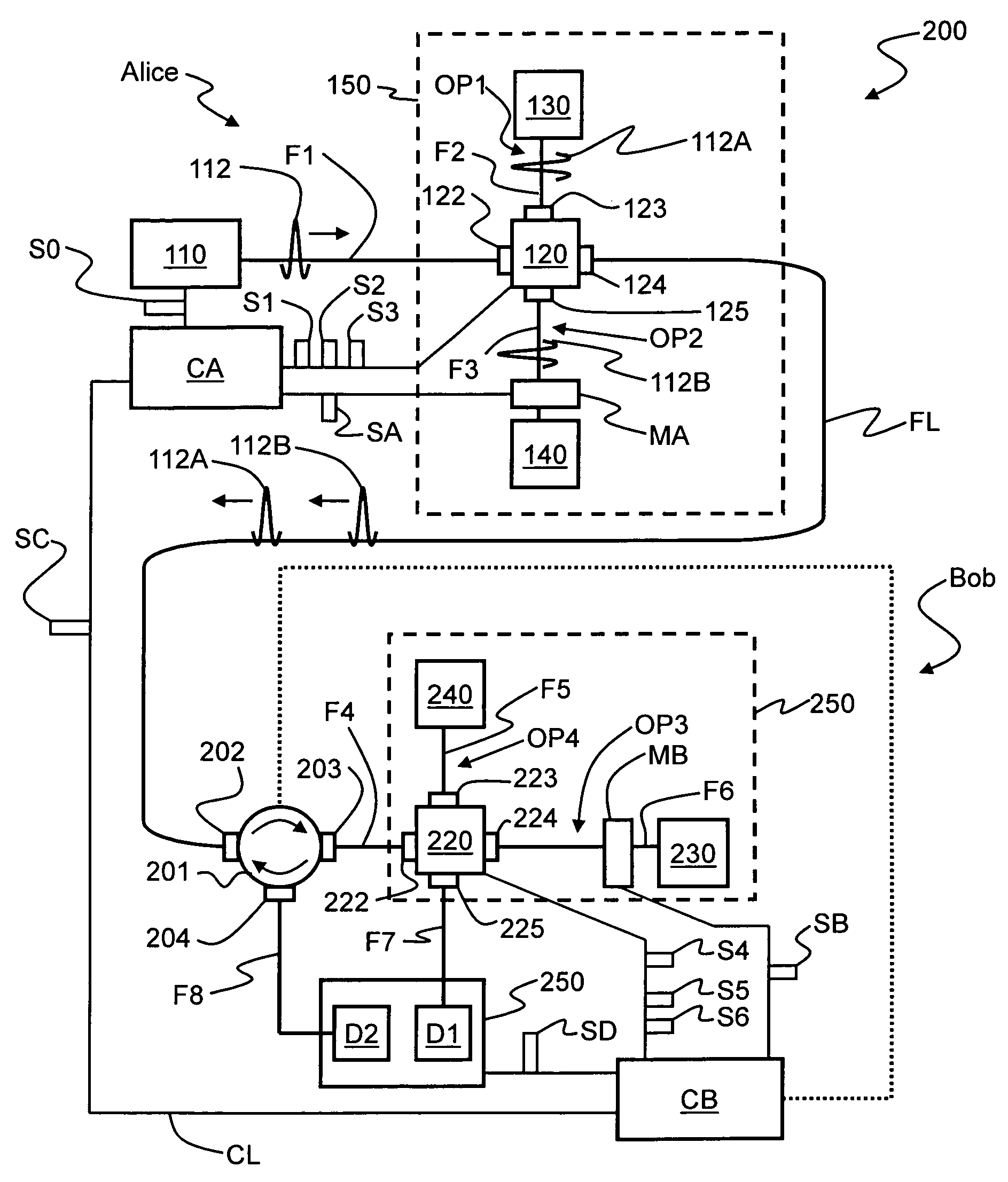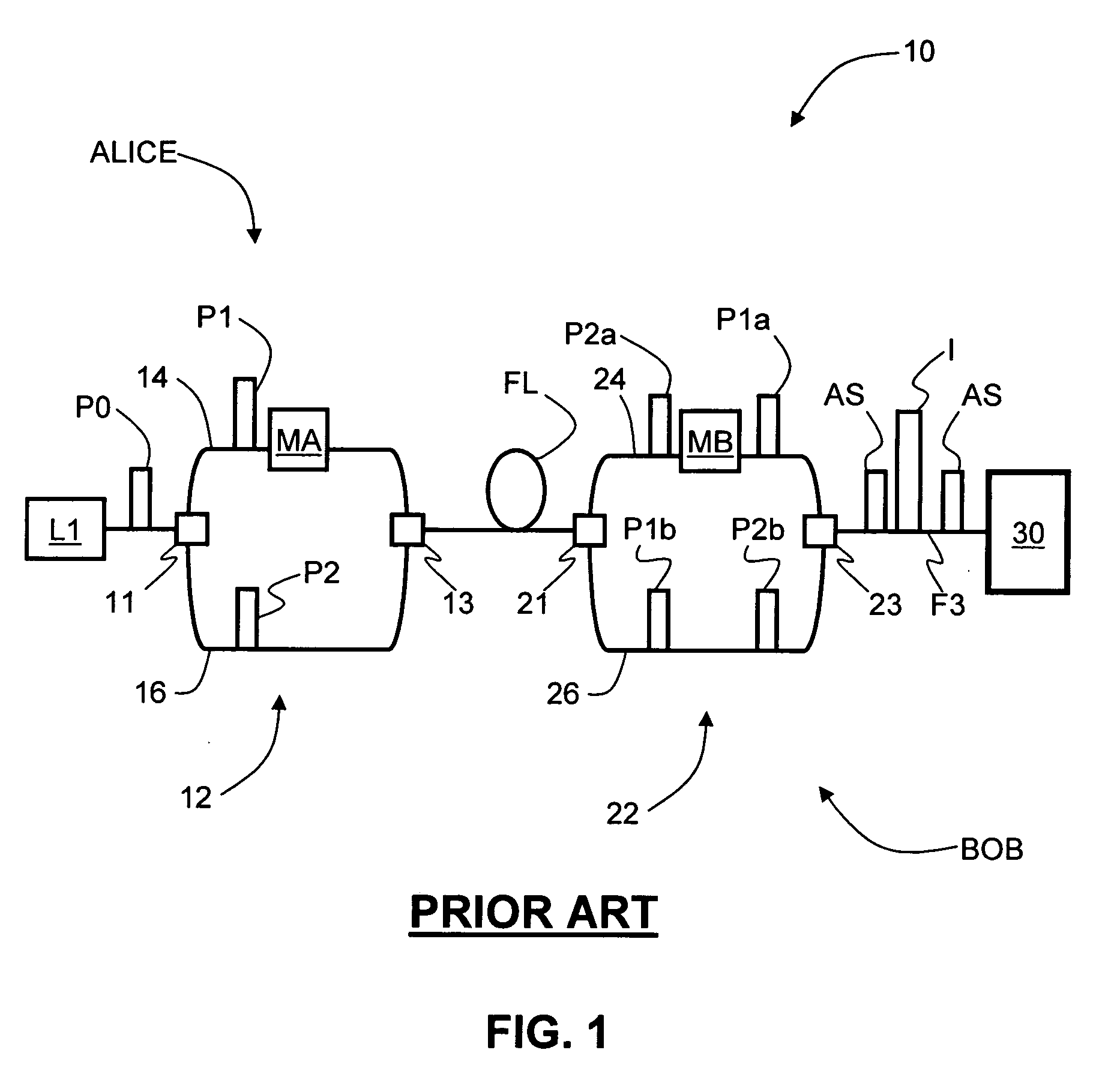Qkd stations with fast optical switches and qkd systems using same
- Summary
- Abstract
- Description
- Claims
- Application Information
AI Technical Summary
Problems solved by technology
Method used
Image
Examples
first example embodiment
I. First Example Embodiment
[0024]FIG. 2 is a schematic diagram of an example embodiment of a QKD system 200 according to the present invention that utilizes QKD stations having fast optical switches and that obviates the need for beamsplitters and optical fiber interferometer loops. QKD system 200 includes two QKD stations Alice and Bob. Alice and Bob are optically coupled, e.g., by an optical fiber link FL. The two QKD stations Alice and Bob are described below, followed by the method of operation of QKD system 100.
Alice
[0025]Alice includes a light source 110 adapted to emit single-photon-level optical pulses 112. In an example embodiment, optical pulses 112 are “quantum signals” that are either each made up of single photons, or are weak coherent pulses (WCPs) having, for example, less than a single photon on average as calculated based on Poissonian statistics.
[0026]Light source 110 is optically coupled to a fast optical switch 120. In an example embodiment, a first optical fiber...
second example embodiment
II. Second Example Embodiment
[0052]FIG. 3 is a schematic diagram of an example embodiment of a QKD system 300 according to the present invention. QKD system 300 is similar to the prior art QKD system 10 shown in FIG. 1. In QKD system 300, however, light source L1 is a weak coherent pulse (WCP) source and fast optical switches 310 and 320 replace beamsplitters 13 and 21. Alice also has a controller CA and Bob has a controller CB. Controllers CA and CB are operably coupled via a communication link CL that carries synchronization signals SC in the manner described in connection with QKD system 200 of FIG. 2.
[0053]Fast optical switch 310 has an output port 312, and two side ports 313 and 314. Similarly, fast optical switch 320 has an input port 322, and two side ports 323 and 324. Fast optical switch 310 has first and second operating states. In the first operating state, the switch directs light entering at side port 313 out of output port 312. In the second operating state, the switch...
third example embodiment
III. Third Example Embodiment
[0058]FIG. 4 is a schematic diagram of a QKD system 400 similar to that of QKD system 300 of FIG. 3, but wherein the light source 110 is a single photon source, and wherein the system includes a single fast optical switch 320 at Bob.
[0059]In the operation of QKD 400, Alice's controller CA sends light source 110 an activation signal S0 that causes the light source SPS to generate a single-photon quantum signal P0. At the same time, controller CA generates synchronization signal SC, which travels over to Bob's controller CB over communication link CL. Single-photon quantum signal P0 travels to beamsplitter 11. Because quantum signal P0 is a single photon, instead of this pulse being split into two, the pulse is described in terms of the probability of it being in one arm of the loop or the other. Hence, pulse P0 is shown as being in both optical fiber sections 14 and 16. Controller CA activates phase modulator MA to coincide with the expected arrival time ...
PUM
 Login to View More
Login to View More Abstract
Description
Claims
Application Information
 Login to View More
Login to View More - R&D
- Intellectual Property
- Life Sciences
- Materials
- Tech Scout
- Unparalleled Data Quality
- Higher Quality Content
- 60% Fewer Hallucinations
Browse by: Latest US Patents, China's latest patents, Technical Efficacy Thesaurus, Application Domain, Technology Topic, Popular Technical Reports.
© 2025 PatSnap. All rights reserved.Legal|Privacy policy|Modern Slavery Act Transparency Statement|Sitemap|About US| Contact US: help@patsnap.com



